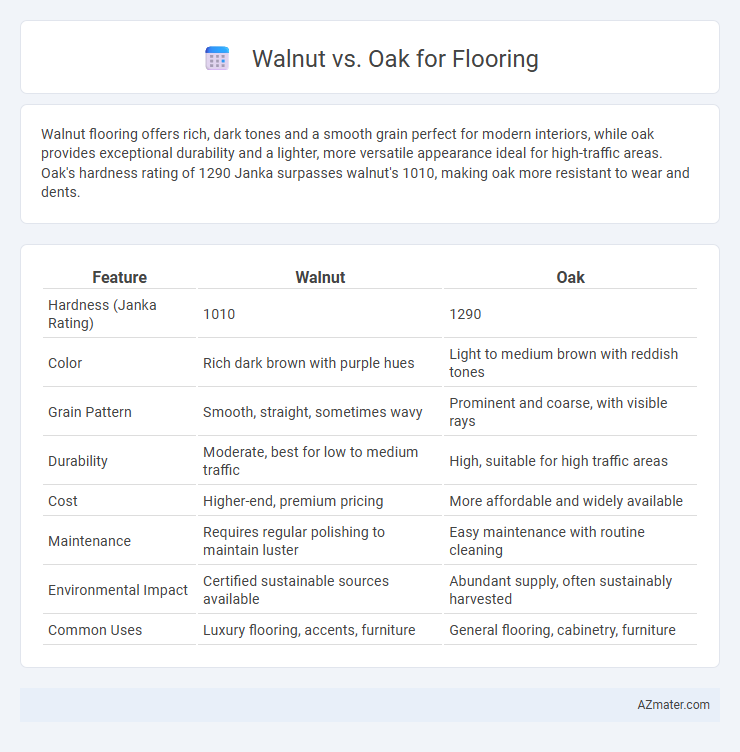Walnut flooring offers rich, dark tones and a smooth grain perfect for modern interiors, while oak provides exceptional durability and a lighter, more versatile appearance ideal for high-traffic areas. Oak's hardness rating of 1290 Janka surpasses walnut's 1010, making oak more resistant to wear and dents.
Table of Comparison
| Feature | Walnut | Oak |
|---|---|---|
| Hardness (Janka Rating) | 1010 | 1290 |
| Color | Rich dark brown with purple hues | Light to medium brown with reddish tones |
| Grain Pattern | Smooth, straight, sometimes wavy | Prominent and coarse, with visible rays |
| Durability | Moderate, best for low to medium traffic | High, suitable for high traffic areas |
| Cost | Higher-end, premium pricing | More affordable and widely available |
| Maintenance | Requires regular polishing to maintain luster | Easy maintenance with routine cleaning |
| Environmental Impact | Certified sustainable sources available | Abundant supply, often sustainably harvested |
| Common Uses | Luxury flooring, accents, furniture | General flooring, cabinetry, furniture |
Walnut vs Oak Flooring: An Overview
Walnut flooring offers rich, dark tones and a smooth grain pattern that enhances luxury interiors, while oak flooring provides exceptional durability with its pronounced grain and lighter color spectrum. Walnut hardwood is prized for its refined elegance and moderate hardness rating of 1,010 on the Janka scale, contrasting with oak's higher hardness of 1,290 (red oak) to 1,360 (white oak), making oak better suited for high-traffic areas. Both species deliver excellent stability and longevity, but walnut's deep hues create a warm, sophisticated ambiance compared to oak's versatile and classic appeal ideal for various design styles.
Appearance and Grain Patterns
Walnut flooring showcases a rich, dark brown color with purple undertones and smooth, straight grain patterns that can sometimes feature gentle waves, creating a warm and elegant aesthetic. Oak flooring offers a lighter, golden to medium brown hue with highly pronounced, intricate grain patterns including rays and flecks, adding texture and visual interest to a room. Both woods provide distinctive appearances suitable for different interior styles, with walnut delivering a more uniform, sophisticated look and oak emphasizing classic, rustic charm through its bold grain.
Color Variations and Aging
Walnut flooring offers rich, dark brown hues with subtle purples and deep chocolate tones that deepen gracefully over time, enhancing its luxurious appeal. Oak flooring displays a wide spectrum of color variations from light honey and golden hues to medium reddish-brown shades, developing a warm amber patina as it ages. The natural aging process in walnut tends to darken and intensify its color, while oak softens and lightens, creating a more rustic, inviting character.
Hardness and Durability
Walnut flooring has a Janka hardness rating of approximately 1,010, making it softer than oak, which ranges between 1,200 (red oak) and 1,360 (white oak). Oak's higher hardness contributes to greater resistance to dents and wear, enhancing its longevity in high-traffic areas. Despite walnut's softer texture, its flexibility allows it to withstand impacts without cracking, offering durable yet elegant flooring options.
Cost Comparison
Walnut flooring typically costs between $8 to $14 per square foot, reflecting its rich color and durability, while oak flooring ranges from $4 to $10 per square foot, making it a more budget-friendly option. The installation expenses for both hardwoods are comparable, usually adding $3 to $5 per square foot. Walnut's higher initial price is offset by its premium appearance and longer lifespan, whereas oak offers a more economical solution with solid performance.
Maintenance and Care Requirements
Walnut flooring requires regular maintenance, including periodic polishing and prompt cleaning of spills to preserve its rich color and prevent scratches. Oak is more durable and resistant to wear, demanding less frequent refinishing and offering easier upkeep in high-traffic areas. Both hardwoods benefit from humidity control and the use of protective coatings to extend their lifespan and maintain aesthetic appeal.
Environmental Impact and Sustainability
Walnut flooring, harvested from slower-growing trees, has a lower carbon sequestration rate compared to oak, which grows faster and captures more carbon dioxide during its growth cycle. Oak is often sourced from sustainably managed forests with certifications like FSC, promoting responsible harvesting and reforestation, whereas walnut's limited availability may lead to overharvesting concerns. Choosing oak flooring can support greater carbon storage and ecosystem balance, making it a more environmentally sustainable option for long-term flooring projects.
Installation Challenges and Methods
Walnut flooring presents installation challenges due to its softer nature, requiring careful handling to avoid dents and scratches, often necessitating professional installation with precise moisture control methods. Oak flooring is denser and more tolerant during installation, allowing for easier nail or staple fastening and compatibility with various subfloor types, which can speed up the process. Both hardwoods benefit from acclimatization before installation to minimize expansion and contraction, but oak's structural robustness generally results in fewer installation issues.
Best Uses and Room Suitability
Walnut flooring excels in living rooms and bedrooms due to its rich, warm tones and natural resistance to wear, creating an elegant yet cozy atmosphere. Oak flooring, known for its durability and classic grain patterns, suits high-traffic areas like hallways and kitchens where strength and longevity are priorities. Both hardwoods adapt well to various interior styles, but walnut's softer texture is better for low-impact spaces, while oak withstands heavy use and moisture fluctuations effectively.
Walnut vs Oak: Which Is Right for Your Home?
Walnut flooring offers rich, dark tones and a smooth grain pattern, providing a luxurious and warm ambiance ideal for elegant or modern interiors. Oak flooring, available in red and white varieties, boasts exceptional durability and a versatile grain pattern that fits rustic to contemporary styles while withstanding high traffic areas. Choosing between walnut and oak depends on your preference for color depth, grain aesthetics, and the specific wear resistance needed for your home environment.

Infographic: Walnut vs Oak for Flooring
 azmater.com
azmater.com